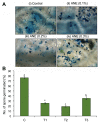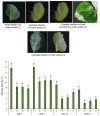A Biostimulant Preparation of Brown Seaweed Ascophyllum nodosum Suppresses Powdery Mildew of Strawberry
- PMID: 31632216
- PMCID: PMC6788409
- DOI: 10.5423/PPJ.OA.03.2019.0066
A Biostimulant Preparation of Brown Seaweed Ascophyllum nodosum Suppresses Powdery Mildew of Strawberry
Abstract
Strawberry, an important fruit crop, is susceptible to a large number of pathogens that reduce fruit quality and productivity. In this study, the effect of a biostimulant prepared from Ascophyllum nodosum extract (ANE) (0.1%, 0.2%, and 0.3%) was evaluated on powdery mildew progression under greenhouse and field conditions. In the greenhouse, application of 0.2% ANE showed maximum reduction in powdery mildew progression as compared to the control. Forty-eight hour post-inoculation, foliar spray of 0.2% ANE reduced spore germination by 75%. Strawberry leaves sprayed with ANE showed higher total phenolic and flavonoid content in response to powdery mildew infection. Furthermore, application of ANE elicited defense response in strawberry plants by induction of defense-related enzymes, such as phenylalanine ammonia lyase, polyphenol oxidase, and peroxidase activity. In field conditions, foliar spray of 0.2% ANE showed a reduction of 37.2% of natural incidence of powdery mildew infection as compared to the control. ANE sprayed plant also reduces the severity of powdery mildew infection under natural conditions. These results indicate that application of ANE induces the strawberry plant's active defense against powdery mildew infection by induction of secondary metabolism and regulating the activities of defense-related enzymes.
Keywords: Ascophyllum nodosum extract; Podosphaera aphanis; phenylalanine ammonia lyase; powdery mildew; strawberry.
© The Korean Society of Plant Pathology.
Figures







References
-
- Abkhoo J, Sabbagh SK. Control of Phytophthora melonis damping-off, induction of defense responses, and gene expression of cucumber treated with commercial extract from Ascophyllum nodosum. J Appl Phycol. 2016;28:1333–1342. doi: 10.1007/s10811-015-0693-3. - DOI
-
- Ali N, Ramkissoon A, Ramsubhag A, Jayaraj J. Ascophyllum extract application causes reduction of disease levels in field tomatoes grown in a tropical environment. Crop Prot. 2016;83:67–75. doi: 10.1016/j.cropro.2016.01.016. - DOI
LinkOut - more resources
Full Text Sources

